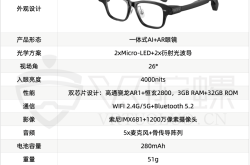[In-Depth Review] Ali's Pioneering AI Glasses Quark S1: A Testament to Innovation!
![]() 11/28 2025
11/28 2025
![]() 435
435
Alibaba's Second-Stage AI Product Unveiled by CEO Wu Yongming
Authored by VR Gyroscope's Ran Qixing
Following in the footsteps of Xiaomi and Baidu, a third major player in China's tech and internet sector has stepped into the realm of AI glasses.
On November 27, Ali Quark hosted the 'Visionary' product launch in Beijing, unveiling the 'Quark AI Glasses S1'. As a pivotal move in Alibaba's AI strategy, the Quark S1 eschews a conservative ODM approach, opting instead for a path rich in innovation. It boasts the 'Qianwen' dialogue assistant, a dual-chip architecture, and a high-density integration of binocular AR waveguide technology with AI photography. This product, grounded in fundamental technological principles, sets the Quark AI Glasses S1 apart from its predecessors by Xiaomi and Baidu, which primarily focused on 'photography'. It extends Ali's expansive service ecosystem to the glasses through AI multimodal interactions, leveraging 'near-eye display' capabilities. Impressively, despite its complex hardware, the glasses weigh just 51g (inclusive of 0-degree myopia lenses). 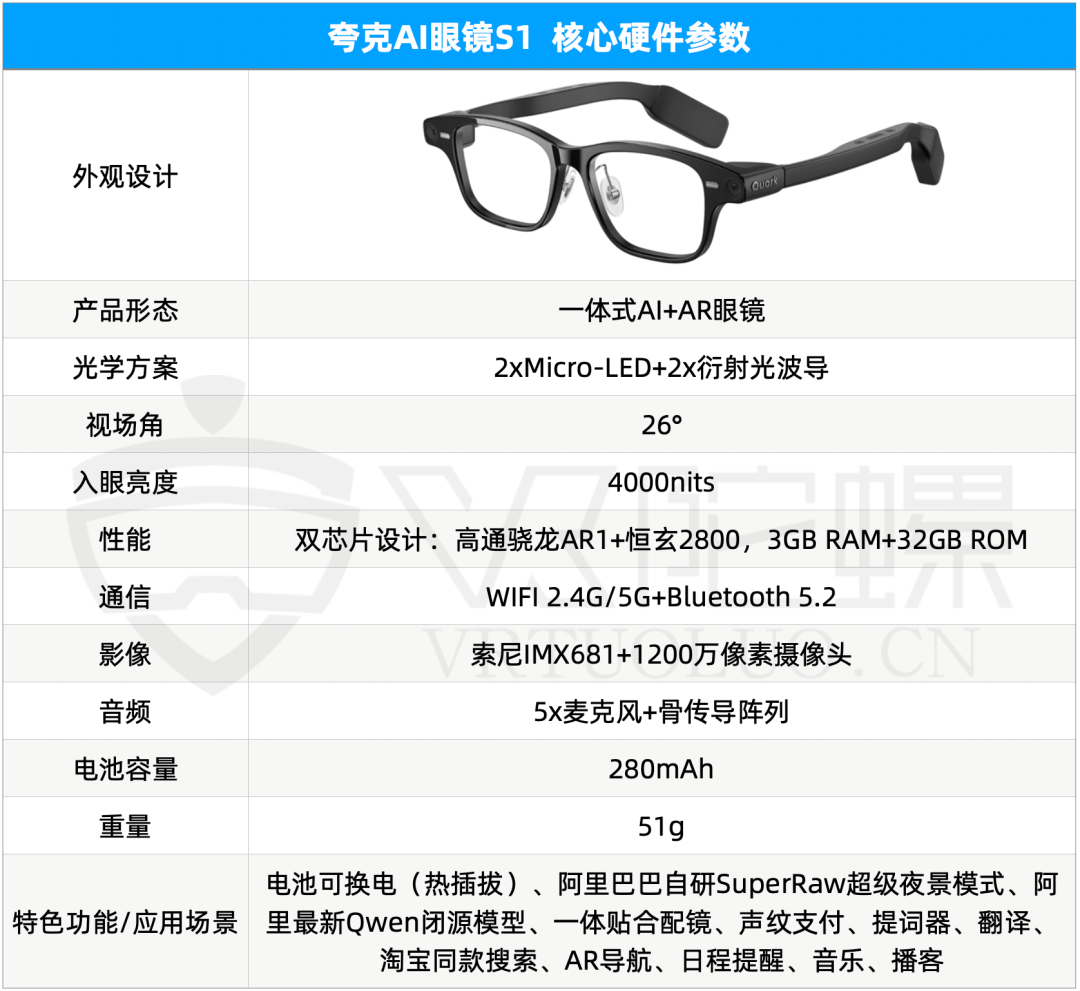
01
7.5mm Ultra-Slim Temple: Quark AI Glasses Redefine 'Tech Elegance'
Before widespread adoption, the primary hurdle for AI glasses may not be technological limitations but rather their 'uniqueness'. A superior pair of AI glasses must first serve as comfortable, unobtrusive 'regular glasses' that seamlessly blend into daily social interactions.
Thus, the Quark AI Glasses S1 incorporates numerous 'clever' design elements that harmonize practicality with user experience. Its initial impression is one of refined industrial design.
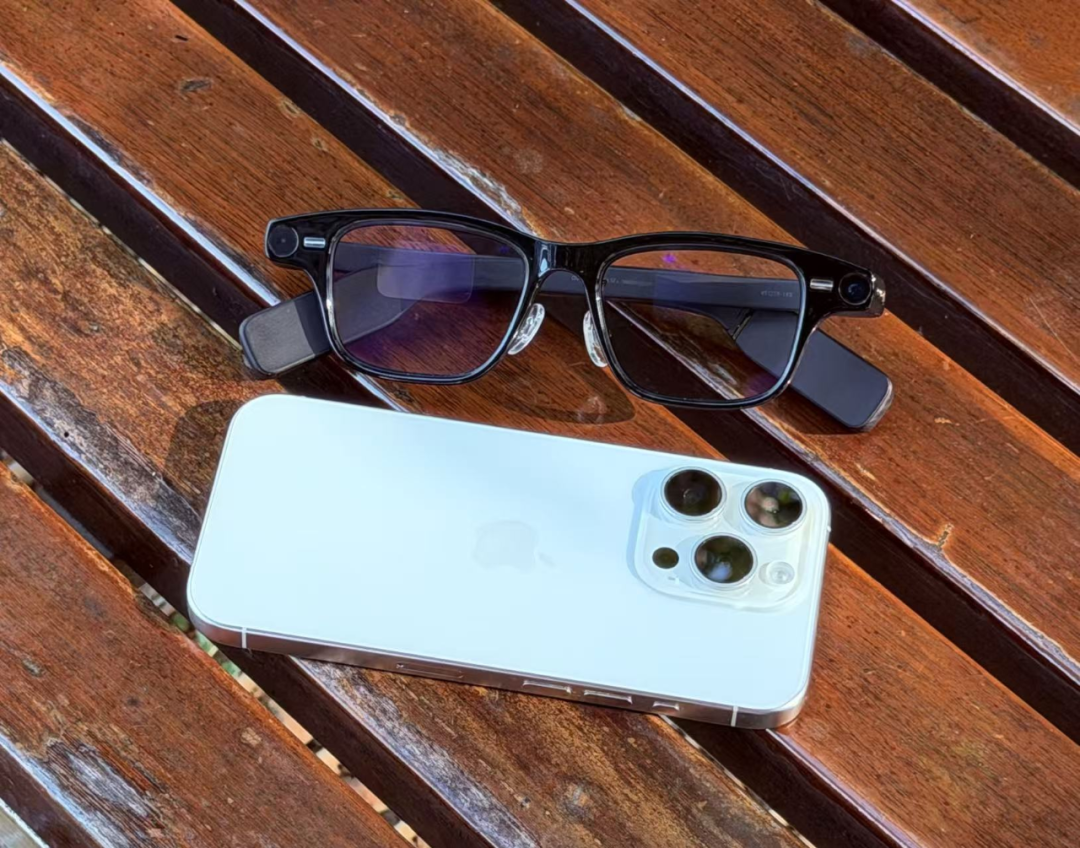
The glasses feature a classic Wellington square frame, predominantly in a sophisticated black hue. To mitigate the conspicuousness of 'cameras and LED indicator lights' on the frame's sides and prevent monotony, silver decorative strips are added, enhancing texture and drawing external attention. 
The 'surface relief grating' area on the lenses seamlessly integrates into the design, primarily covering the 'upper-middle' region. This minimizes the 'rainbow effect' in human vision and ensures 'virtual images' do not overly obstruct the physical view during direct eye contact. The grating area, cut into rounded rectangles, aligns with the product's aesthetic, reducing external attention.
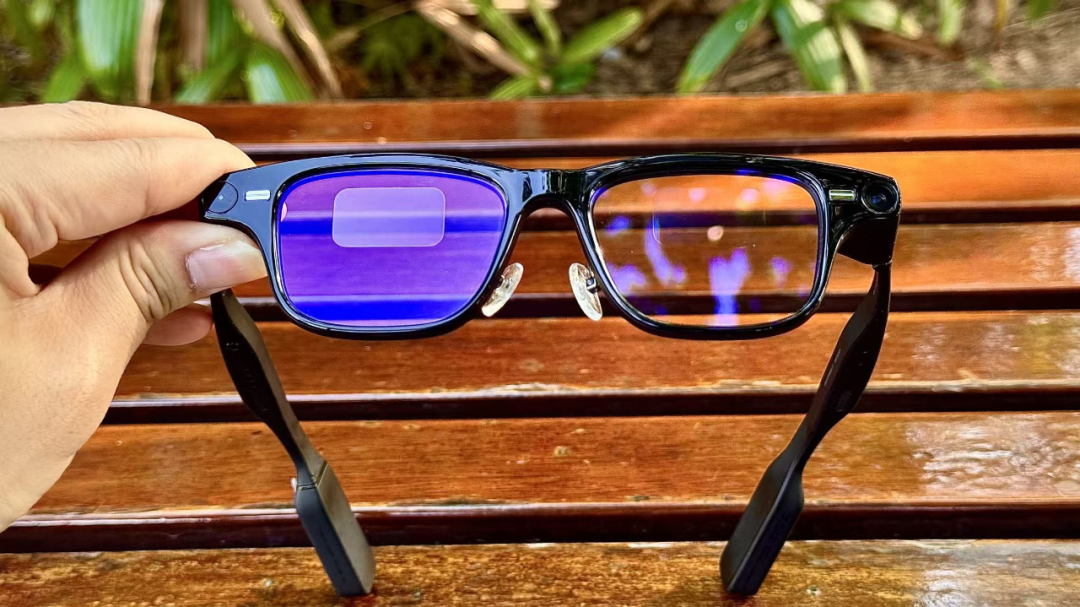
In temple design, a challenging aspect for capability integration, the Quark S1 achieves an impressive 7.5mm (at its narrowest point). This is accomplished through a specialized internal structure: transforming the traditionally thick side design into a wedge shape, visible only from above, with the wider middle section housing dual linear speakers; relocating the mainboard and PCB to the temple's end, behind the ears and concealed by hair and color, ensuring a fashionable appearance. This 'visual' enhancement makes it difficult for onlookers to distinguish from ordinary thick-framed myopia glasses when viewed from the side. 
Notably, the dual linear speakers on the temples feature a refined zoning design: three independent acoustic meshes in the upper temple area and one in the lower area. By controlling different sound emission structures, various sound effect releases are achievable (currently, three modes: standard, powerful, and quiet sound effects).

Beyond visual 'lightness', the Quark S1 maintains an overall weight of around 51g, placing it in the top tier among binocular waveguide solution competitors. However, 'lightness' alone does not guarantee comfort; a 'balanced' ergonomic design is crucial.
The Quark AI Glasses S1 employs a 1:1 front-to-back balanced weight distribution, significantly reducing nasal bridge pressure during wear. Even during rapid walking, phone viewing, or significant head turns, the glasses remain firmly attached without the annoying 'top-heavy' or frame-slipping phenomena. Given the weight at the temple's end, prolonged wear may cause slight ear pressure for non-regular glasses wearers.
 Wearing Quark AI Glasses with 100-level beauty filter (Source: VR Gyroscope)
Wearing Quark AI Glasses with 100-level beauty filter (Source: VR Gyroscope)
02
High Brightness, Light Leakage Prevention, Rainbow Effect Reduction: Ideal for 'All-Day' Wear
In optical solution selection, the Quark AI Glasses S1 adopts a 'two-dimensional binocular diffractive waveguide + Micro-LED' combination, currently the optimal balance between display effects and all-day wearability.
Thanks to the high refractive index glass substrate and extremely high physical lens transmittance, along with the grating's positional design, the common 'rainbow effect' in diffractive waveguides is significantly suppressed. Coupled with a green light engine boasting an in-eye brightness of up to 4000nit, AR menu text remains clear and sharp even outdoors under direct afternoon sunlight.  Quark AI Glasses menu (captured with a mobile phone, actual experience may vary)
Quark AI Glasses menu (captured with a mobile phone, actual experience may vary)
Addressing the common 'privacy light leakage' issue in AR glasses, the S1 optimizes the underlying grating process, making it nearly impossible for others to detect bright spots on the lenses from the front or side, effectively safeguarding information privacy.
Furthermore, a significant technical highlight of the S1 is the 'adjustability of virtual imaging distance'. Unlike traditional AR glasses with fixed virtual image distances, the S1 supports multi-level adjustments from 2 to 10 meters, which is extremely friendly for users with mild myopia or presbyopia—when the virtual image at 5 meters becomes blurry, adjusting to the 2-meter level restores clear vision.
03
Dual-Chip Architecture: Balancing Photography, AR Display, and Long Battery Life
In hardware configuration, the Quark AI Glasses S1 adopts a 'Qualcomm first-generation Snapdragon AR1 + BES2800 by Hengxuan' dual-chip architecture. This represents a typical 'division of labor' logic: the Snapdragon AR1 Gen 1 serves as the primary computing center, handling high-load AI visual computing, high-definition image ISP processing, and complex algorithm scheduling; meanwhile, the Hengxuan BES2800 acts as a coprocessor, managing low-power Bluetooth connectivity, audio decoding, and all-day standby tasks. This architecture effectively balances the conflicts between image capture, microdisplay, and long battery standby.
VR Gyroscope's actual testing under high-frequency usage—capturing dozens of photos, short video clips, listening to music, AR navigation, and information prompt activations—revealed that a 280mAh battery can last approximately 4 hours. Under normal usage scenarios, it can generally last a full day. According to official data, the Quark AI Glasses S1 can achieve up to 25 hours of standby wake time, including 45 minutes of calls, 2.5 hours of music listening, 20 minutes of navigation, and 15 instances of 1-minute recordings; typical battery life reaches 7 hours, including 30 photo captures, 5 minutes of continuous AI assistant usage, 2 minutes of image transmission, and 2.95 hours of voice standby.
This dual-chip drive advantage is also reflected in the imaging system. The S1 is equipped with a Sony IMX681 sensor featuring a 109° ultra-wide FOV. Although its pixel parameters may not match smartphone main cameras, this sensor excels in single CMOS light sensitivity and Qualcomm ISP support.
In testing, the Quark AI Glasses S1 demonstrated outstanding performance in both normal daylight and night photography compared to similar products. Under daylight conditions: as shown below, the sky's transparency and purity are maximized, avoiding common color shifts or grayness in cheaper devices; building whites appear clean and soft, with color reproduction nearing the level of daily consumer flagship smartphones. 
Original outdoor scene photo (Source: VR Gyroscope)
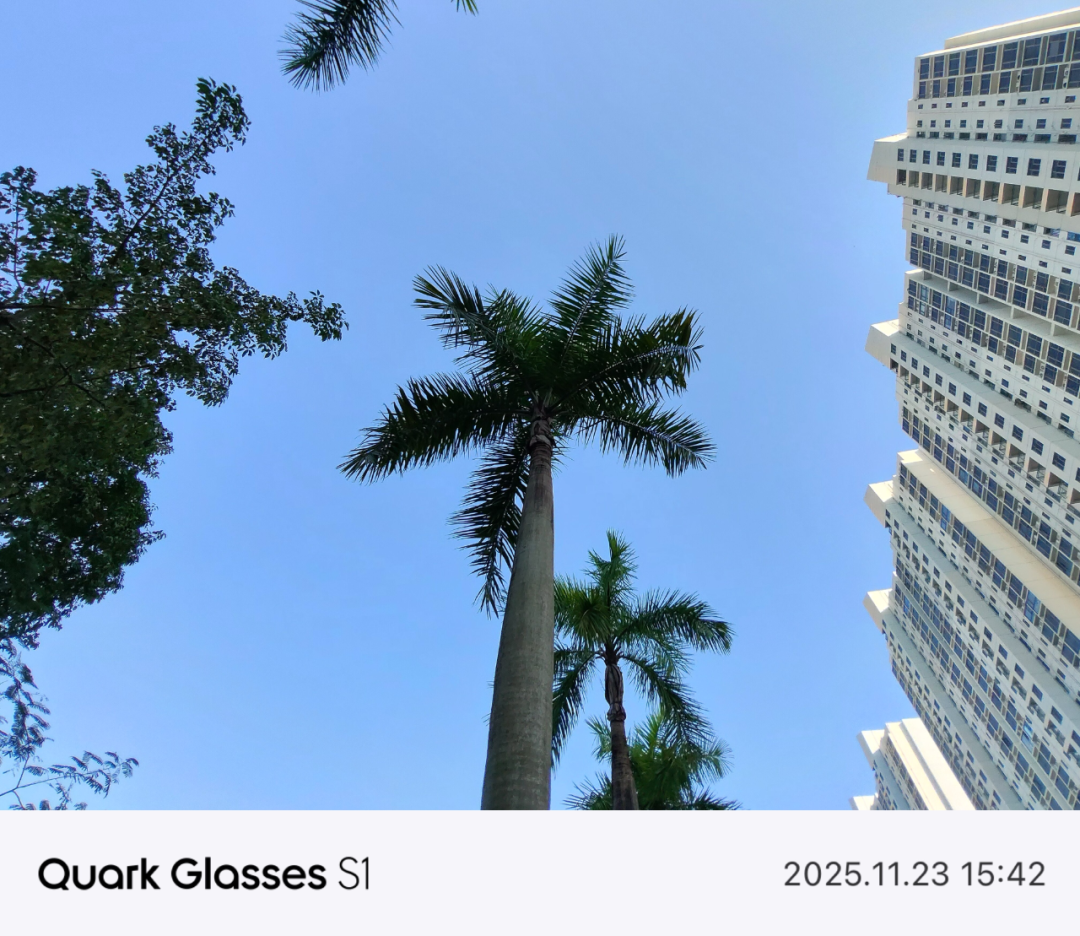
Original outdoor scene photo (Source: VR Gyroscope)
 Outdoor scene photo—cool color style (Source: VR Gyroscope)
Outdoor scene photo—cool color style (Source: VR Gyroscope) 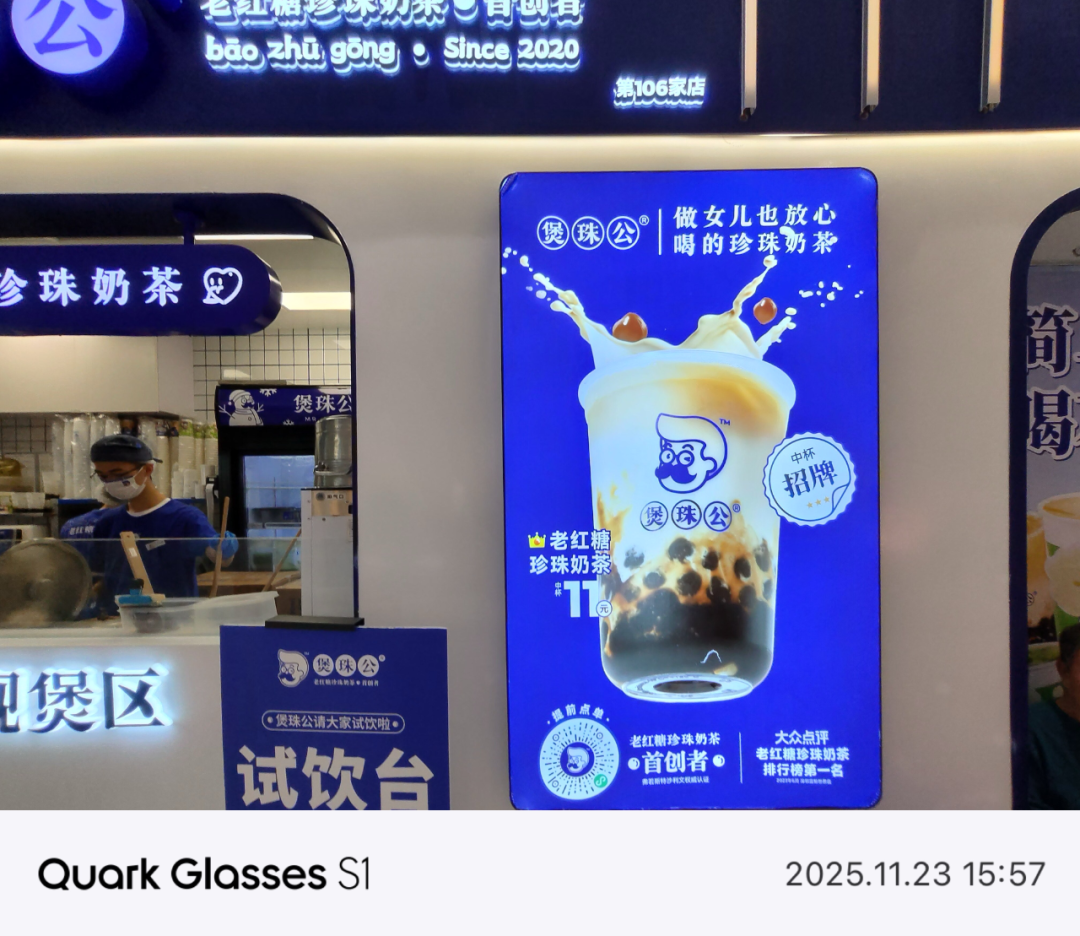
Indoor scene photo (Source: VR Gyroscope)
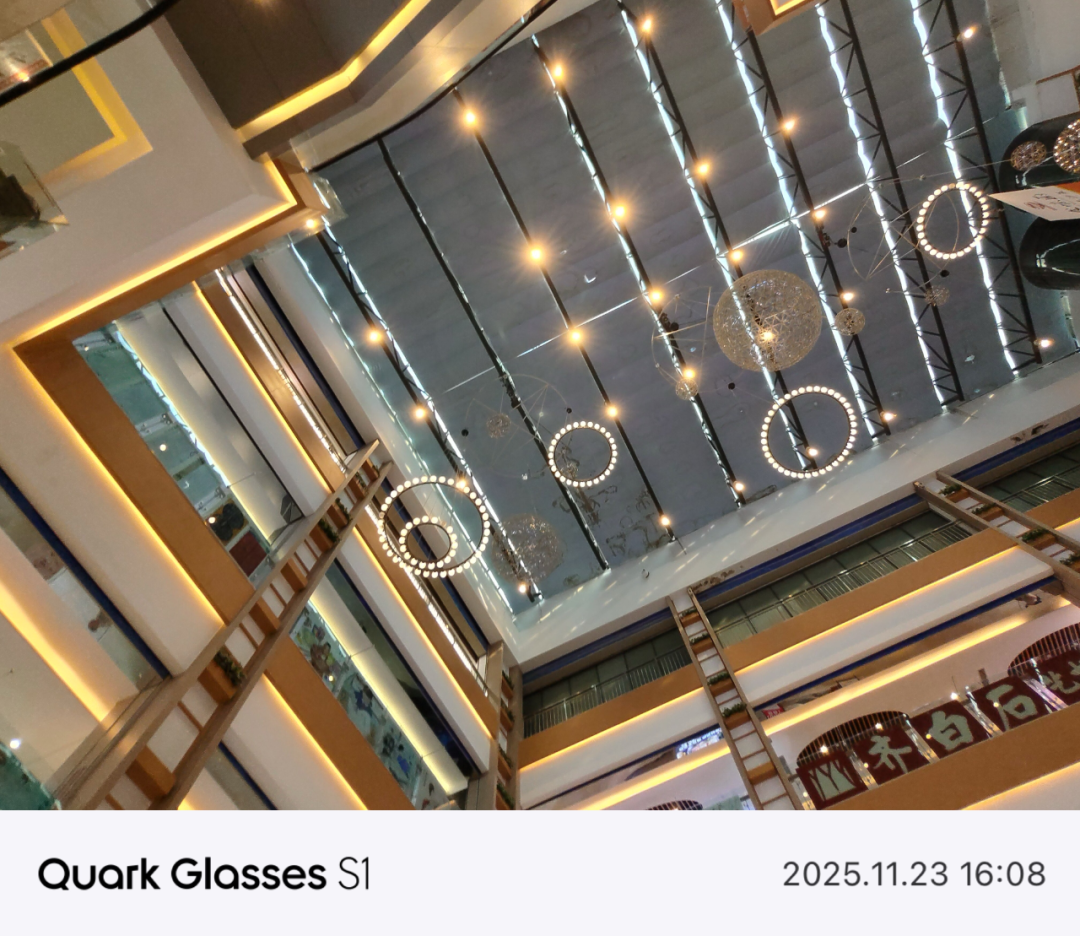
Indoor scene photo (Source: VR Gyroscope)
Thanks to the SuperRaw low-light processing algorithm, the Quark AI Glasses S1 achieves a balance between noise suppression and detail retention in low-light environments with a single-camera setup. Night scene imaging clarity is significantly enhanced in texture and overall effect compared to similar single-camera products, meeting user demands for low-light usage.
As shown in the actual photo below, under low light, tree branch textures remain clear instead of blurring into shadows; dark area noise is well-controlled without the graininess of cheaper devices; tower crane glare and building lights are not overexposed, with clear highlights and no chaotic glare.
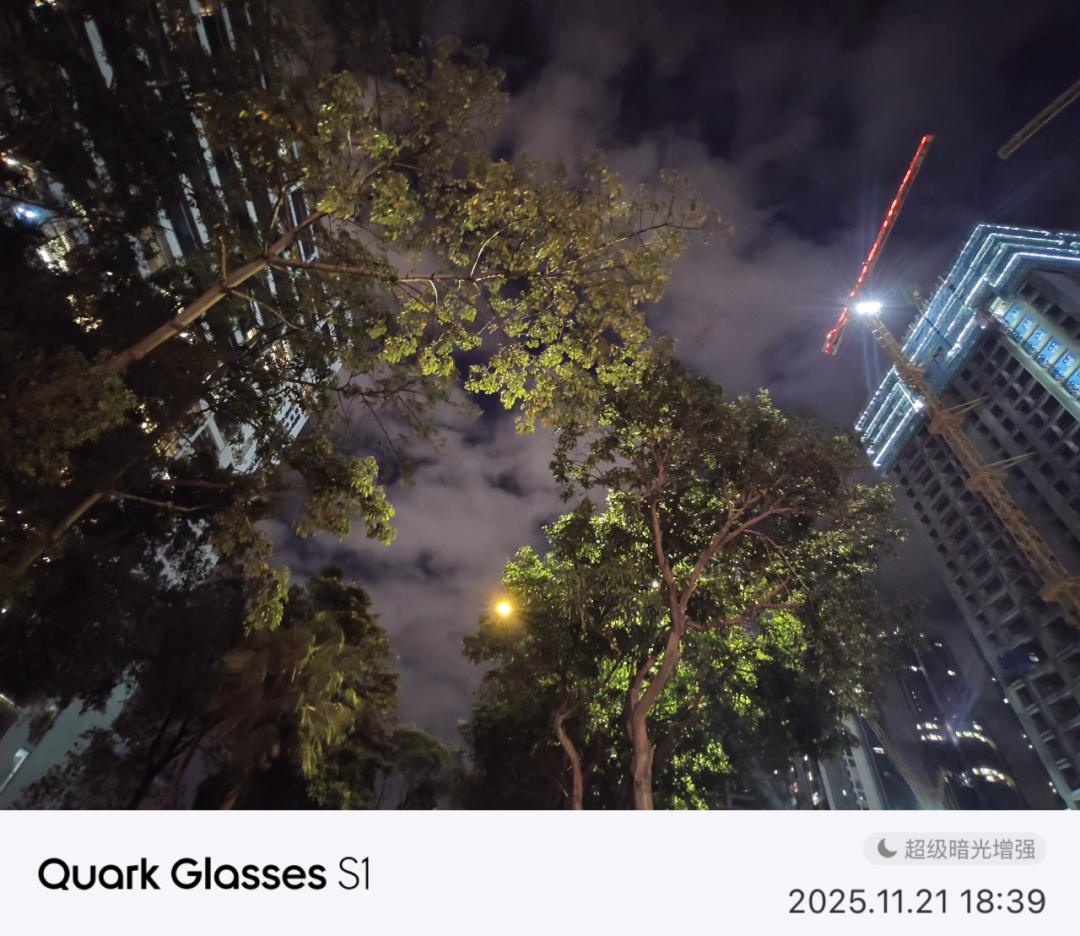
Original outdoor scene photo (Source: VR Gyroscope)
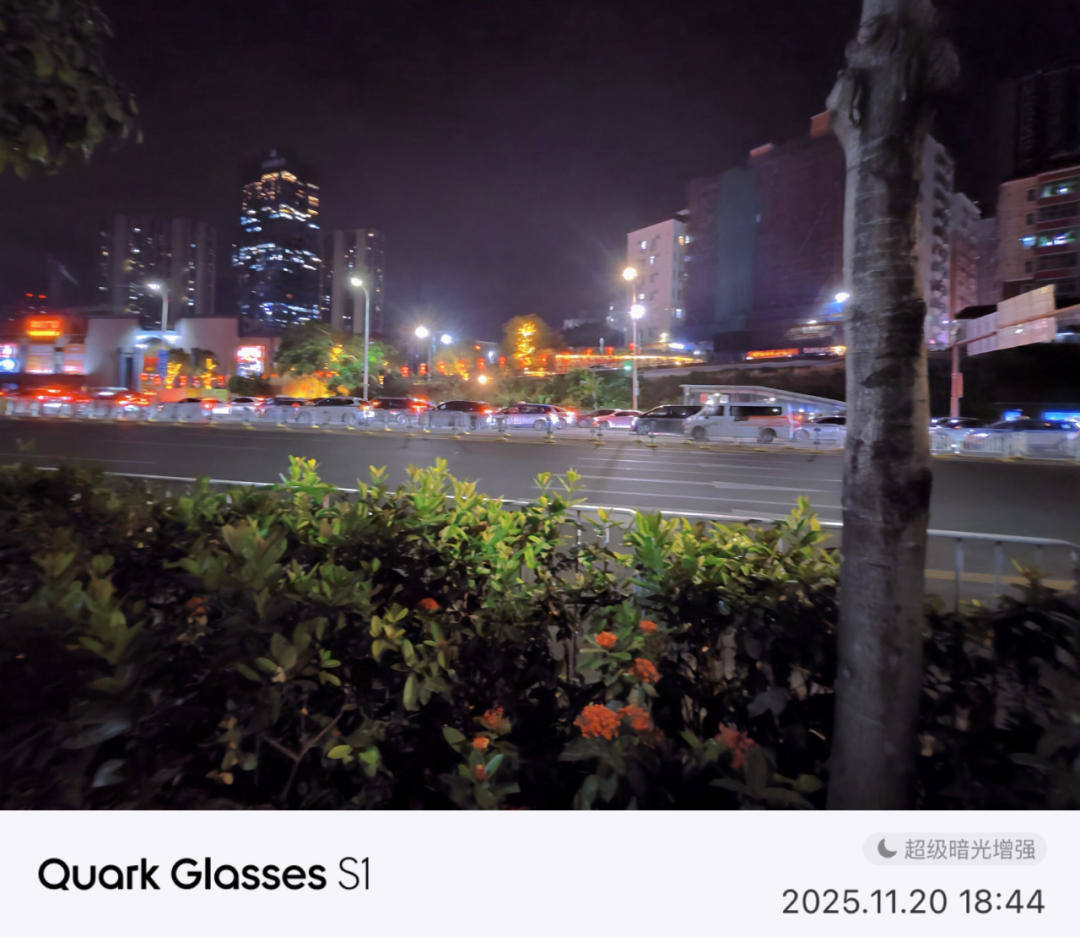
Outdoor scene photo—urban night style (Source: VR Gyroscope)
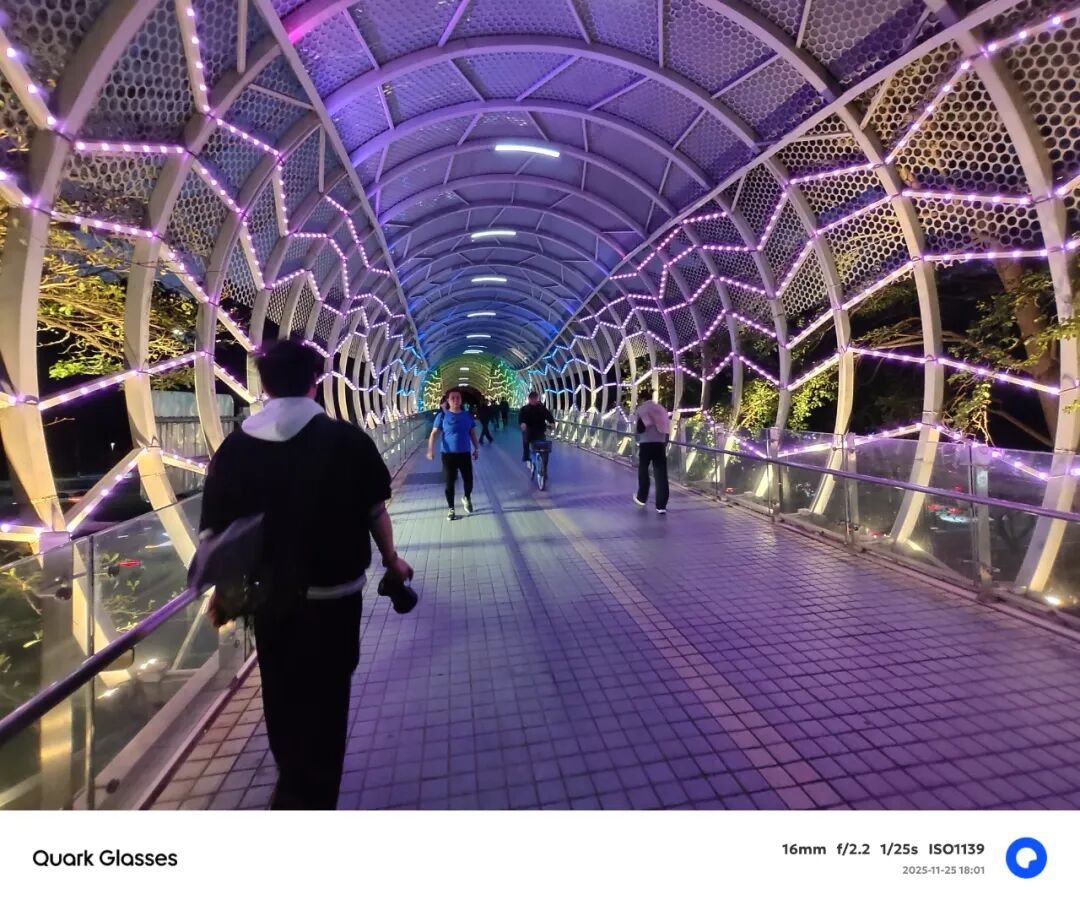
Outdoor scene photo (Source: VR Gyroscope)
In video recording, the Quark AI Glasses support 1080P and 3K recording modes, with 1080P allowing up to 10 minutes per session and 3K mode up to 3 minutes per session. Overall video quality and stabilization effects are excellent, meeting social media sharing standards.
Sample video from Quark AI Glasses recording mode (Source: VR Gyroscope)
From the series of sample photos taken, the Quark AI Glasses S1 demonstrates imaging performance approaching mainstream flagship smartphone levels. For glasses, the core value of their imaging system may not lie in pixel parameter stacking but in 'instant capture capability' from a first-person perspective, clearly and quickly freezing life moments—perhaps this is the true meaning of AI glasses' imaging function.
04
Alibaba's 'Strategic Advantage': Transforming AI Glasses into a Super Gateway
The essence of AI glasses lies in 'AI'. The Kwark S1 is equipped with the 'QianWen' dialogue assistant, which can be activated by saying 'Hello QianWen,' 'Hello Kwark,' or by touching the control area on the right temple of the glasses. Its interaction logic is designed to balance physical touch and natural voice control.
The S1 integrates four interaction zones on the temple (camera zone, display control zone, media control zone, and power button), with clearly defined functions. Although first-time users may need a few minutes to learn how to avoid accidental touches, once familiar, blind operation becomes possible.
Notably, in interaction design, since AI glasses lack a 'shooting preview,' most AI glasses rely primarily on 'auto-focus' for shooting. The Kwark AI glasses, however, feature 'capacitive sensing' on the shooting button. Users can simply touch it to sense the object in their current line of sight, with focus indicators displayed through the waveguide lens, further enhancing photo quality.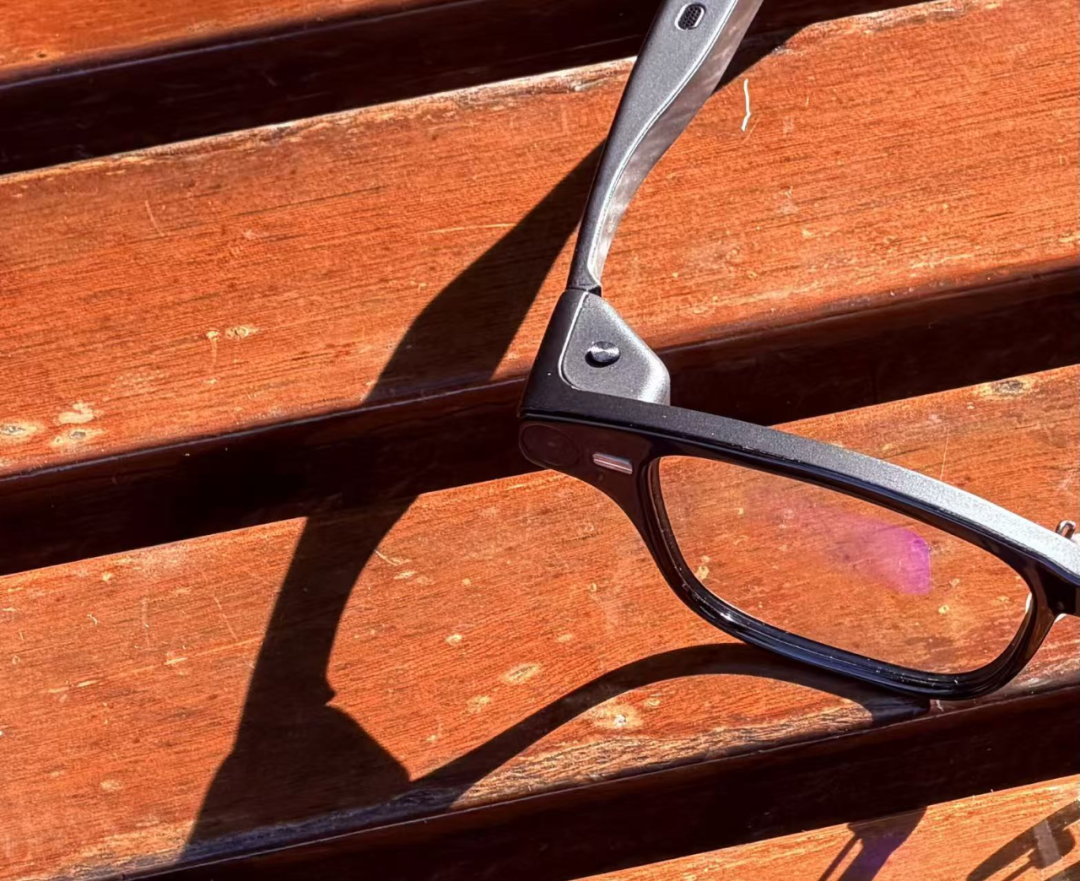
Beyond touch interaction, AI voice interaction is a core capability of the Kwark S1. To achieve precise voice pickup in open acoustic environments, the S1 is equipped with a hardware combination of a '5-microphone array + 1 bone conduction mic,' ensuring accurate recognition of user commands even in noisy settings.
For an AI glasses product, it is not only essential for the AI to understand but also for users to hear clearly. In basic audio playback, the Kwark AI glasses seem to have elevated the experience to the pinnacle of open speakers. As mentioned earlier, through its seemingly 'unconventional' acoustic mesh design, the Kwark AI glasses offer three audio modes: 'Standard,' 'Powerful,' and 'Quiet.'
VR Gyroscope testing demonstrated that in an indoor office setting, with the volume set at 50% and a distance of 30cm, the standard and powerful sound effects were almost imperceptible to bystanders. The quiet mode further reduced sound leakage from the open speakers, rendering the sound barely audible even at a mere 10cm. From the author's perspective, the powerful sound mode is exceptionally well-suited for a variety of settings, including offices, outdoor environments, shopping malls, and cycling scenarios. The Kwark AI glasses have already showcased remarkable proficiency in 'long-distance sound cancellation' for open speakers. Leveraging this capability, the immersive, surround-sound quality of the powerful mode emerges as the top choice for discerning ears.
In key application scenarios, the Kwark AI glasses S1 highlight the product advantages inherent in Alibaba's ecosystem, acting as a super gateway. Unlike competitors that merely offer 'AI image recognition,' the S1 deeply integrates Alibaba's core service capabilities: it connects with Taobao for 'product price comparison'; it integrates with Alipay for voiceprint payment, enabling users to complete transactions with a single voice command; and it combines data from Gaode Maps and Fliggy for real-time navigation and travel services. This 'hardware-software integration' ecosystem synergy constitutes the deepest competitive moat that sets the Kwark S1 apart from other AI glasses.
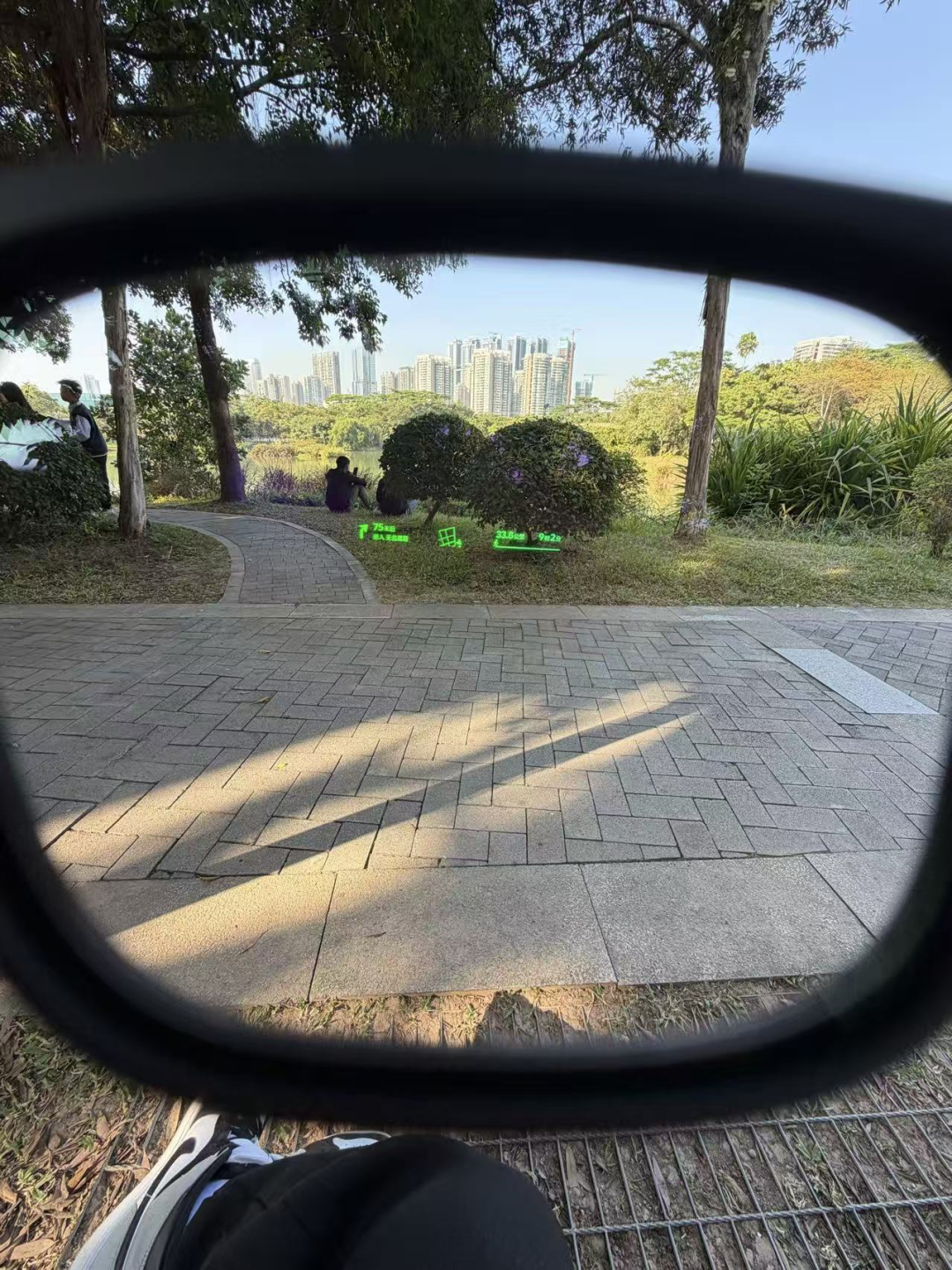 Demonstration of the navigation function (image captured via phone; actual experience may vary)
Demonstration of the navigation function (image captured via phone; actual experience may vary)
Demonstration of the teleprompter function (image captured via phone; actual experience may vary)
Built on a binocular AR near-eye display system, the Kwark AI glasses also support essential functions such as WeChat message notifications, teleprompters, translation, and other specialized scenarios. These features help users reduce their reliance on phones. Messages can appear in real-time without the need to pull out the phone, the teleprompter can adapt to speeches seamlessly, and translation covers multiple languages, addressing high-frequency application needs in daily life, work, and travel.
Undeniably, from Taobao's e-commerce services and Alipay's voiceprint payment to Fliggy's travel information and Gaode Maps' navigation capabilities, these super apps, which cover users' daily needs and boast both traffic and functional advantages, have significantly bolstered the market competitiveness of the Kwark AI glasses S1.
05
Conclusion
For Alibaba, the Kwark AI glasses S1 represent not merely an entry into wearable hardware but a strategic move to transition the capabilities of 'QianWen' from 'fingertips' to 'in front of the eyes.' While Ray-Ban Meta initially validated the market potential of the 'audio + camera' form factor, the Kwark S1 aims to open the door to further commercialization.
At the opening ceremony of the 2025 World Internet Conference Wuzhen Summit, Alibaba Group CEO Wu Yongming stated that AI development will progress through three stages: intelligent emergence, artificial general intelligence (AGI), and 'artificial superintelligence (ASI).' According to Wu, we are now at the dawn of the second stage of AI development. In other words, AGI is no longer a distant concept but has already arrived. This is evident from the fact that 'when we present demands to AI, AI Agents can now complete a wide array of tasks in the digital world and connect to the real world through interfaces to operate some physical devices. The defining characteristic of AI at this stage is its ability to 'assist humans.'
Today, the Kwark AI glasses S1 we observe embody the AI Agents of this era, connecting to various application scenarios through built-in interfaces, streamlining processes, and fulfilling needs with a single click.

